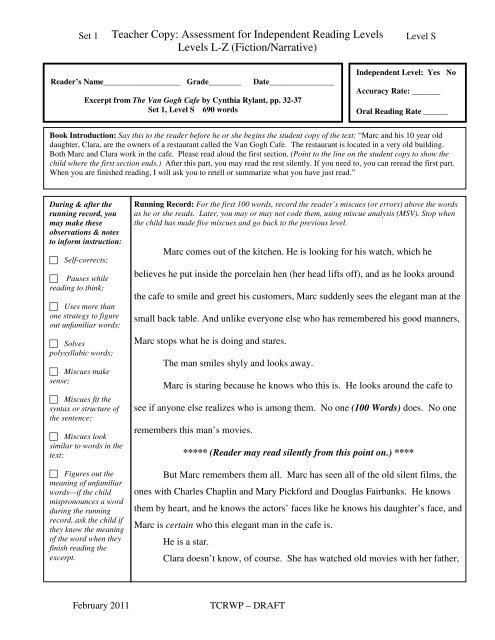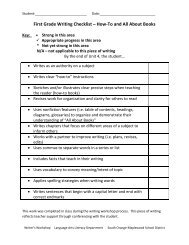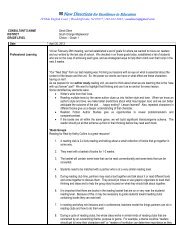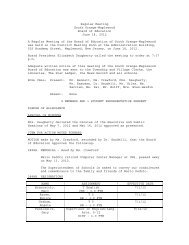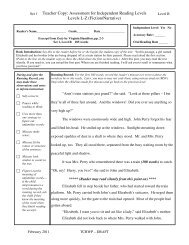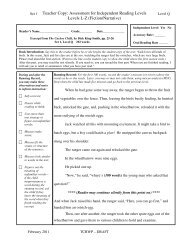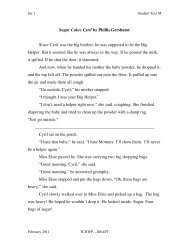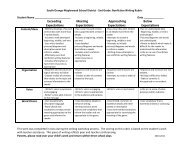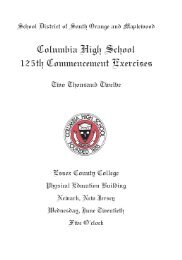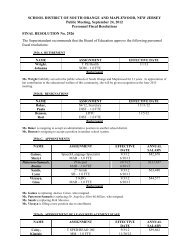Teacher Copy: Assessment for Independent Reading Levels Levels ...
Teacher Copy: Assessment for Independent Reading Levels Levels ...
Teacher Copy: Assessment for Independent Reading Levels Levels ...
You also want an ePaper? Increase the reach of your titles
YUMPU automatically turns print PDFs into web optimized ePapers that Google loves.
Set 1<br />
<strong>Teacher</strong> <strong>Copy</strong>: <strong>Assessment</strong> <strong>for</strong> <strong>Independent</strong> <strong>Reading</strong> <strong>Levels</strong><br />
<strong>Levels</strong> L-Z (Fiction/Narrative)<br />
Level S<br />
Reader’s Name___________________ Grade________<br />
Date________________<br />
Excerpt from The Van Gogh Cafe by Cynthia Rylant, pp. 32-37<br />
Set 1, Level S 690 words<br />
<strong>Independent</strong> Level: Yes No<br />
Accuracy Rate: _______<br />
Oral <strong>Reading</strong> Rate ______<br />
Book Introduction: Say this to the reader be<strong>for</strong>e he or she begins the student copy of the text: “Marc and his 10 year old<br />
daughter, Clara, are the owners of a restaurant called the Van Gogh Cafe. The restaurant is located in a very old building.<br />
Both Marc and Clara work in the cafe. Please read aloud the first section. (Point to the line on the student copy to show the<br />
child where the first section ends.) After this part, you may read the rest silently. If you need to, you can reread the first part.<br />
When you are finished reading, I will ask you to retell or summarize what you have just read.”<br />
During & after the<br />
running record, you<br />
may make these<br />
observations & notes<br />
to in<strong>for</strong>m instruction:<br />
Self-corrects;<br />
Pauses while<br />
reading to think;<br />
Uses more than<br />
one strategy to figure<br />
out unfamiliar words;<br />
Solves<br />
polysyllabic words;<br />
Miscues make<br />
sense;<br />
Miscues fit the<br />
syntax or structure of<br />
the sentence;<br />
Miscues look<br />
similar to words in the<br />
text;<br />
Figures out the<br />
meaning of unfamiliar<br />
words—if the child<br />
mispronounces a word<br />
during the running<br />
record, ask the child if<br />
they know the meaning<br />
of the word when they<br />
finish reading the<br />
excerpt.<br />
Running Record: For the first 100 words, record the reader’s miscues (or errors) above the words<br />
as he or she reads. Later, you may or may not code them, using miscue analysis (MSV). Stop when<br />
the child has made five miscues and go back to the previous level.<br />
Marc comes out of the kitchen. He is looking <strong>for</strong> his watch, which he<br />
believes he put inside the porcelain hen (her head lifts off), and as he looks around<br />
the cafe to smile and greet his customers, Marc suddenly sees the elegant man at the<br />
small back table. And unlike everyone else who has remembered his good manners,<br />
Marc stops what he is doing and stares.<br />
The man smiles shyly and looks away.<br />
Marc is staring because he knows who this is. He looks around the cafe to<br />
see if anyone else realizes who is among them. No one (100 Words) does. No one<br />
remembers this man’s movies.<br />
***** (Reader may read silently from this point on.) ****<br />
But Marc remembers them all. Marc has seen all of the old silent films, the<br />
ones with Charles Chaplin and Mary Pick<strong>for</strong>d and Douglas Fairbanks. He knows<br />
them by heart, and he knows the actors’ faces like he knows his daughter’s face, and<br />
Marc is certain who this elegant man in the cafe is.<br />
He is a star.<br />
Clara doesn’t know, of course. She has watched old movies with her father,<br />
February 2011<br />
TCRWP – DRAFT
Set 1<br />
<strong>Teacher</strong> <strong>Copy</strong>: <strong>Assessment</strong> <strong>for</strong> <strong>Independent</strong> <strong>Reading</strong> <strong>Levels</strong><br />
<strong>Levels</strong> L-Z (Fiction/Narrative)<br />
Level S<br />
but, except <strong>for</strong> Chaplin, she doesn’t know the actors. Only their movements.<br />
And it is perhaps the way the elegant man has (200 Words) moved through the cafe that reminds<br />
her of something she has seen be<strong>for</strong>e. Reminds everyone. But none can quite place the memory.<br />
The breakfast hours pass and people go their way, to work, to the mall at the edge of town, back<br />
home to put up a tree.<br />
But the elegant man stays on. He has hardly touched his egg. His teacup is still half full. The<br />
door of the Van Gogh Cafe opens and closes, opens and closes, and he stays on, looking out the window.<br />
Marc cannot help himself. When there is no one left in the cafe (300 Words) except the silent<br />
star, Marc walks over to his table. Clara, curious, shyly follows.<br />
Please see “Student <strong>Copy</strong>” <strong>for</strong> the remainder of the text.<br />
Total miscues including<br />
self-corrected: _____<br />
Self-corrections: _____<br />
Miscues reader did not<br />
self-correct: ______<br />
Accuracy Rate: Circle the number of miscues the reader did not self-correct.<br />
100% 99% 98% 97% 96%<br />
0 miscues 1 miscue 2 miscues 3 miscues 4 miscues<br />
96%-100% accuracy is necessary to determine the reader’s independent reading level.<br />
Try a lower level text if the reader made 5 or more miscues.<br />
* If the child makes the same miscue repeatedly, count it as one miscue.<br />
Literal and Inferential Retelling or Summary<br />
Say, “Please retell or summarize what you just read.” Write notes regarding the student’s retelling or summary on the back of<br />
this page. If the student has trouble getting started, you can prompt him/her. Make a note that you prompted the student.<br />
Use the Retelling Rubric and Sample Student Responses to determine if the child’s retelling and responses to the<br />
comprehension questions are acceptable. If a student answers a comprehension question as part of the retelling you do not<br />
have to ask him/her that question. Students at this level should be able to retell/summarize a story using elements of<br />
narrative text structure.<br />
Optional: You may ask the student to write his/her responses to this section on the attached <strong>for</strong>ms. If you choose this option,<br />
observe the student as he/she writes. You must follow up any incorrect written response with a chance <strong>for</strong> the student to<br />
answer the question orally.<br />
February 2011<br />
TCRWP – DRAFT
Set 1<br />
<strong>Teacher</strong> <strong>Copy</strong>: <strong>Assessment</strong> <strong>for</strong> <strong>Independent</strong> <strong>Reading</strong> <strong>Levels</strong><br />
<strong>Levels</strong> L-Z (Fiction/Narrative)<br />
Comprehension Questions Section: Analyze the student’s retelling/summary to see if it contains in<strong>for</strong>mation that answers<br />
each question below. If a question was not answered in the retelling, ask it and record the student’s response.<br />
1. Literal Question: What does Marc do when he first sees the elegant old man?<br />
2. Literal Question: What kind of films does Marc remember?<br />
3. Inferential Question: What does Clara mean when she says, “She knows the cafe remembers this man?”<br />
4. Inferential Question: What changes <strong>for</strong> Clara from the beginning of the text to the end of the text?<br />
Level S<br />
Oral <strong>Reading</strong> Fluency Scale – Circle the Appropriate Level<br />
Fluent<br />
Level<br />
4<br />
Level<br />
3<br />
Reads primarily in larger, meaningful phrase groups. Although some regressions, repetitions, and deviations from text<br />
may be present, these do not appear to detract from the overall structure of the text. Preservation of the author’s syntax<br />
is consistent. Most of the text is read with expressive interpretation.<br />
Reads primarily in three or four-word phrase groups. Some small groupings may be present. However, the majority of<br />
phrasing seems appropriate and preserves the syntax of the author. Some expressive interpretation is present; this may<br />
be inconsistent across the reading of the text.<br />
Non fluent<br />
Level<br />
2<br />
Level<br />
1<br />
Reads primarily in two-word phrases with some three or four-word groupings. Some word-by-word reading may be<br />
present. Word groupings may seem awkward and unrelated to larger context of sentence or passage. Beginning a little<br />
expressive interpretation, frequently first seen when reading dialogue.<br />
Reads primarily word-by-word. Occasional two-word or three-word phrases may occur—but these are infrequent and/or<br />
they do not preserve meaningful syntax. No expressive interpretation.<br />
Adapted from: U.S. Department of Education, Institute of Education Sciences, National Center <strong>for</strong> Education Statistics, National<br />
<strong>Assessment</strong> of Educational Progress (NAEP), 2002 Oral <strong>Reading</strong> Study.<br />
Level S Benchmarks <strong>for</strong> Oral <strong>Reading</strong> Rate (Words Per Minute)<br />
Oral reading rate is the number of words per minute the reader reads with accuracy, intonation and meaningful phrasing.<br />
Level 1<br />
Needs Support<br />
Level 2<br />
Approaches Standards<br />
Level 3<br />
Meets Standards<br />
Level 4<br />
Exceeds Standards<br />
79 wpm or less 80-109 wpm 110-145 wpm 146 wpm or more<br />
Please refer to the Benchmarks <strong>for</strong> Student Progress <strong>for</strong> details regarding Oral <strong>Reading</strong> Rate.<br />
Final Score<br />
Yes No Was the reader’s accuracy rate at least 96%?<br />
Yes No Did the student read with fluency? (a score of 3 or 4 on the Oral <strong>Reading</strong> Fluency Scale)<br />
Yes No Did the reader correctly answer at least 3 questions in the Comprehension Questions Section?<br />
Yes No Did the retelling/summary express the important things that happened in the text?<br />
Is this the student's independent reading level?<br />
• If you did NOT answer “yes” to all four questions in this Final Score box, try an easier text. Keep moving to easier texts until you find the level at<br />
which you are able to answer “yes” to all four questions in the Final Score box.<br />
• If you circled four “yes” answers in this Final Score box, the student is reading strongly at this level. However, it is possible that the student may also<br />
read strongly at a higher level. Keep moving to higher passages until you can no longer answer “yes” to all four questions. The highest level that<br />
showed strong reading is the independent reading level. For example, you might find that you answered “yes” to all four questions in the Final Score<br />
box <strong>for</strong> level P, then a “yes” to all four questions <strong>for</strong> level Q, but only three “yes” answers <strong>for</strong> level R. Level Q is the highest passage on which you<br />
were able to answer “yes” to all four questions in the Final Score box. Level Q is the current independent reading level <strong>for</strong> the student.<br />
February 2011<br />
TCRWP – DRAFT
Name:<br />
Set 1<br />
<strong>Teacher</strong> <strong>Copy</strong>: <strong>Assessment</strong> <strong>for</strong> <strong>Independent</strong> <strong>Reading</strong> <strong>Levels</strong><br />
<strong>Levels</strong> L-Z (Fiction/Narrative)<br />
Date:<br />
Level S<br />
In writing, retell or summarize what you just read.<br />
________________________________________________________________________<br />
________________________________________________________________________<br />
________________________________________________________________________<br />
________________________________________________________________________<br />
________________________________________________________________________<br />
________________________________________________________________________<br />
________________________________________________________________________<br />
________________________________________________________________________<br />
________________________________________________________________________<br />
________________________________________________________________________<br />
________________________________________________________________________<br />
________________________________________________________________________<br />
________________________________________________________________________<br />
________________________________________________________________________<br />
February 2011<br />
TCRWP – DRAFT
Name:<br />
Set 1<br />
<strong>Teacher</strong> <strong>Copy</strong>: <strong>Assessment</strong> <strong>for</strong> <strong>Independent</strong> <strong>Reading</strong> <strong>Levels</strong><br />
<strong>Levels</strong> L-Z (Fiction/Narrative)<br />
Date:<br />
Level S<br />
Please answer these questions in your own words. You may use extra paper if you need it.<br />
Question #1: What does Marc do when he first sees the elegant old man?<br />
____________________________________________________________________________________<br />
____________________________________________________________________________________<br />
____________________________________________________________________________________<br />
Question #2: What kind of films does Marc remember?<br />
____________________________________________________________________________________<br />
____________________________________________________________________________________<br />
____________________________________________________________________________________<br />
Question #3: What does Clara mean when she says, “She knows the cafe remembers this man?”<br />
____________________________________________________________________________________<br />
____________________________________________________________________________________<br />
____________________________________________________________________________________<br />
Question #4: What changes <strong>for</strong> Clara from the beginning of the text to the end of the text?<br />
____________________________________________________________________________________<br />
____________________________________________________________________________________<br />
____________________________________________________________________________________<br />
February 2011<br />
TCRWP – DRAFT


